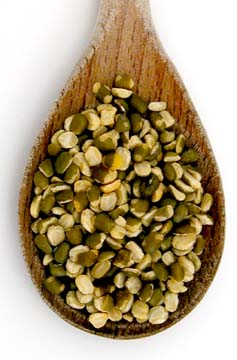
Eleanor Nakama-Mitsunaga
![]()
|
Next to the soy bean, the mung bean is probably the most important legume in Asia. Mung beans are used in many ways, but are most commonly sprouted into bean sprouts.
The basics: Mung beans, also known as dried green beans or mongo beans in the Philippines, are native to India. They are generally green, but also come in yellow and black. The mung beans are housed in skinny, dark pods, primarily harvested to be dried.
The green beans resemble petite peas, but are even smaller. When soaked in water they sprout into the crunchy bean sprout that is indispensable in Asian cuisine.
Mung bean flour is made from dried beans and used to make cellophane noodles, also known as long rice or bean thread noodles. The whole bean is cooked and eaten in soups, rice gruel, puddings and desserts, or ground into a paste for pastries, the way the azuki bean is used in making mochi.
This versatile legume is a good source of protein and in sprouted form is a source of vitamin C. Studies have also concentrated on its cancer- preventing properties.
Selecting: Dried mung beans are available in packages, found alongside other dried beans such as azuki and soybeans. The beans are sold whole or split.
Storing: Mung beans, like other dried beans, can last for a year or so if stored in an airtight container in a dry area. Cooked mung beans should be refrigerated and will generally keep for about three days.
Use: Mung beans can be presoaked, but that's not necessary. Add just enough water to cover the beans, bring to a boil and let simmer for about 30 minutes. The beans will cook faster than other beans because of their tiny size. Drain beans and use in soups, jook or chill. They are also used in Southeast Asian desserts with tapioca strips, fruits and coconut milk. A popular Filipino dish includes mung beans simmered with pork, garlic, fish sauce, tomatoes, okra and sweet potato leaves.
Where to buy: Dried mung beans are available at Asian markets or in Asian food sections of supermarkets. Prices are very reasonable at 65 cents to $1 a bag, depending on quantity.
Eleanor Nakama-Mitsunaga is
a free-lance food writer. Contact her
online through features@starbulletin.com


